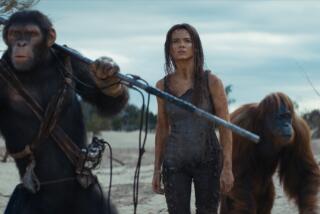Myths, Monsters and the Wealth of Success for ‘Independence Day’
- Share via
The makers of “Dragonheart”--one of this summer’s box-office disappointments--got it half right: Contemporary audiences really do want to see fantasies about fire-breathing dragons and heroic knights. Unfortunately, the half that they got wrong cost them umpteen-million dollars. In the Internet Age, literal dragons with smoking nostrils and spiky tails seem as stodgy and quaint as sword-wielding knights on horseback. To modern-day moviegoers (as last summer’s Arthurian bomb, “First Knight,” already proved), all that clanky old medieval stuff is about as relevant as a Victor Mature gladiator epic.
By contrast, the creators of “Independence Day” have produced a perfect fantasy for our times. Not that the film is without its critics. Over the last couple of weeks, I have found myself embroiled in half a dozen disputes with assorted Grinch-like acquaintances who delight in deriding its implausibilities. One grumbles about the aliens’ ridiculous sense of strategy (“Why didn’t they just destroy their targets from outer space instead of entering Earth’s atmosphere and leaving themselves open to counterattack?”). Another sneers at the unbelievable climax. A third snorts at the notion that anyone, even a guy as cool as Will Smith, could punch out the lights of an alien monster encased in biomechanical body armor.
What none of these nit-pickers seems to understand is that “ID4” never makes the slightest claim to sci-fi feasibility. From its opening allusion to “Star Wars”--a shot of an intergalactic leviathan roaring onto the screen from above--the film informs us that it is not “hard” science fiction but pure, playful fantasy: We have entered into the realm of the marvelous, of heroic romance. Its creators have hit the Hollywood jackpot because they have managed--through a combination of calculation, luck and old-fashioned narrative intuition--to give the mass audience exactly what it craves: an age-old wonder tale, reinvented in precisely the terms that speak to the contemporary sensibility.
There is another name for those age-old stories that exert such an enduring hold on the human imagination: “myths.” The term is notoriously tricky to define. My own favorite definition was given many centuries ago by the Roman historian Sallust: “Myths,” he wrote, “are things that never happened but always are.”
*
‘ID4” is a perfect example of what Sallust meant. On the one hand, almost nothing that takes place during its 2 1/2-hour running time ever did, could or will happen. On the other, it tells a story that audiences have always demanded to hear. Essentially, that story involves a peaceable kingdom (in this case, the Earth itself, first seen floating serenely in the heavens) that is laid waste by a seemingly invincible monster (a fire-breathing dragon or devouring Sphinx or monstrous white shark).
To defeat this creature and restore the land to wholeness, a fellowship of heroic individuals joins forces. There is a wise ruler, once the noblest fighter in the land, who has laid down his arms to assume the leadership of the realm (think of King Arthur or Tennyson’s Ulysses). There is a dashing Lancelot, who revels in his martial skills. There is a veteran warrior, fallen into disgrace, who must redeem himself through a final self-sacrificial act of heroism. And then there is the ordinary man who holds the key to the monster’s destruction and must discover unsuspected reserves of bravery within himself (J.R.R. Tolkien, a great scholar of myth, produced such a character in the hobbit Frodo, protagonist of “The Lord of the Rings”).
In “ID4,” these characters are embodied by Bill Pullman as a former Gulf War hero and current U.S. president, Will Smith as a hotshot fighter pilot, Randy Quaid as a buffoonish crop-duster who reclaims his lost dignity, and Jeff Goldblum as a reluctantly heroic computer nerd. It is no small part of the movie’s appeal that these figures constitute what Swiss psychologist C.G. Jung called a “quaternity”--a union of four distinct personalities who, when joined together, form a whole that is greater than the sum of their parts. This archetypal motif appears in imaginative works of every kind, from myths and folklore to such pop favorites as Fantastic Four comic books, “The Wizard of Oz” and the TV sitcom “Seinfeld.”
Of course, there’s a lot more to “ID4” than its mythic underpinnings. As many pundits have noted, it’s a cheerful compendium of every cultural preoccupation that defines our millennial moment, from UFO paranoia to black-Jewish relationships. And that’s exactly why the film is pulling in all the ticket-buyers who turned up their noses at “Dragonheart.” The need to experience stories about heroic warriors saving their kingdoms from fire-breathing dragons appears to be deeply rooted in the human imagination.
But in the days of the “X-Files,” we want these stories decked out in the most up-to-the-minute fashion. And that’s exactly what the makers of “Independence Day” have given us: a timeless myth in the trendiest garb.
More to Read
Only good movies
Get the Indie Focus newsletter, Mark Olsen's weekly guide to the world of cinema.
You may occasionally receive promotional content from the Los Angeles Times.










